CIA is the World Assassins
Sunlight does not Cause Skin Cancer
General Milley: “you are the board of directors for this corporation we call the United States government.”
Can we think this through for a moment? … I see 2 possibilities. Let me explain.
Option 1.) Milley just admitted that we are a corporation.
Most of us have been led to believe that Trump bankrupted the US corporation and it’s possible he will be the 19th President of the US by way of the original Constitution.
In simple terms, Trump’s capitulation tour did many things. But one of them is believed that he took out the 3 pillars of that corporation. The Royal Family, the Vatican, and the foreign land we call DC. A trilogy partnership in central banking.
Beware of WEF and Bill Gates-funded Apeel – the dangerous new food coating that can’t be washed off.
Robert F. Kennedy Jr, commented on the release of a new damning fluoride toxicity report:
“These findings fly in the face of the empty, unscientific claims U.S. health officials have propagated for years; namely that water fluoridation is safe and beneficial. It’s past time to eliminate this neurotoxin from our water supply, “This is the FIRST time any big-name politician has said anything remotely negative about fluoride.
namely that water fluoridation is safe and beneficial. It’s past time to eliminate this neurotoxin from our water supply, “This is the FIRST time any big-name politician has said anything remotely negative about fluoride.
Results from a new study have illustrated the power of our beliefs and their effect on us.
The study found—for the first time—that people’s beliefs about medications can affect their behavior and how their brains respond.
The researchers say the effects they observed are similar to the dose-dependent effect of medications—where the effects of a medication change when the dosage is changed.
The results have far-reaching implications for the understanding and treatment of mental disorders.
Findings from the study could help scientists understand how a person’s beliefs affect mechanisms in the brain and the role they may play in addiction. They could also help scientists better understand the way treatments using medications as well as other types of therapies could be enhanced by leveraging the power of our beliefs.
“Beliefs can have a powerful influence on our behavior, yet their effects are considered imprecise and rarely examined by quantitative neuroscience methods,” Xiaosi Gu, senior author of the study, said in a press release.
“We set out to investigate if human beliefs can modulate brain activities in a dose-dependent manner similar to what drugs do, and found a high level of precision in how beliefs can influence the human brain. This finding could be crucial for advancing our knowledge about the role of beliefs in addiction as well as a broad range of disorders and their treatments.”
To further examine this relationship, nicotine-dependent study subjects were told an electronic cigarette they were given had either low, moderate, or high levels of nicotine when, in fact, the level of nicotine remained the same. After vaping, the participants had brain imaging via fMRI (functional magnetic resonance imaging) while performing a task known to stimulate parts of the brain activated by nicotine.
The scans showed that the thalamus—which binds to nicotine in the brain—responded in a dose-dependent manner that aligned with the study participant’s beliefs about the nicotine’s strength.
Until now, this effect was thought to only apply to medications.
Ms. Gu is one of the world’s leading researchers in a new field known as computational psychiatry.
Ms. Gu addresses another way that her team’s findings could be applied in clinical practice.
“The finding that human beliefs about drugs play such a pivotal role suggests that we could potentially enhance patients’ responses to pharmacological treatments by leveraging these beliefs,” she says.
Ms. Gu and her research team have uncovered a vital piece of the puzzle in regard to how our subjective beliefs affect the brain and behavior. Their insights could lead to a greater understanding of how mental health disorders develop and the role a patient’s beliefs may play in their treatment.
“We’re interested in testing the effects of beliefs on drugs beyond nicotine to include addictive substances like cannabis and alcohol, and therapeutic agents like antidepressants and psychedelics. It would be fascinating to examine, for example, how the potency of a drug might impact the effect of drug-related beliefs on the brain and behavior, and how long-lasting the impact of those beliefs might be. Our findings could potentially revolutionize how we view drugs and therapy in a much broader context of health.”
Ivermectin — treatment for Covid is now supported by 113 studies, 73 of which have been peer reviewed with links below.
Activated Charcoal, Chlorophyll, Chlorella, Spirulina, Irish Sea Moss, C-60, Power Immunity, Infrared Sauna, Green Tea, Alkaline Water, Probiotics, Cinnamon & Raw Honey, Avocado, Garlic, Turmeric, Cilantro, Ginger, Cruciferous vegetables & leafy greens are also great detoxes for the body.
DON’T USE IF YOU’RE TRYING TO GET PREGNANT, CURRENTLY PREGNANT OR NURSING.
Kills parasites, bacteria, bacterium, tape worms, round worms, spirochetes
No issues with ivermectin, even if you
have a mold allergy, can’t overdose on it
Cures:
Tick borne pathogens (LYME Disease):
Cancers: Cures
Allergies: Cures
Improving Disorders/Syndromes💥❤️🔥
VACCINE DETOX:
Bath soak Detox removes: Radiation, Heavy Metals,
Pesticides, Nano Technology, Parasites.
2 cups Baking Soda
2 cups Epson Salts
1 cup Bentonite Clay
1 cup Borax
Scrub down 20 minute as hot as you can take it.
https://www.carriemadej.com/products
Detox Parasites/Heavy Metals:
https://www.thedetoxdudes.com/posts/heavy-metal-parasite-detox-saved-my-life
https://www.thedetoxdudes.com/posts/heavy-metal-parasite-detox-saved-my-life
https://www.therawtruthteller.com/post/parasites-heavy-metals
https://naturalsociety.com/proper-heavy-metal-chelation-cilantro-chlorella/
I use this:
https://www.iherb.com/tr/cb?pcodes=PTF-10658qty2&rcode=DXB2159&utm_medium=appshare
Ivermectin treatment for Covid is now supported by 113 studies, 73 of which have been peer reviewed. This includes 63 controlled trials with a total of 26,398 patients, and 31 Randomized Controlled Trials. Here is a direct link to 51 of them https://www.nature.com/articles/s41429-021-00430-5https://iv.iiarjournals.org/content/34/5/3023.longhttps://www.frontiersin.org/articles/10.3389/fmicb.2020.592908/fullhttps://www.futuremedicine.com/doi/10.2217/fvl-2020-0342https://doi.org/10.2217/fvl-2020-0342https://www.sciencedirect.com/science/article/pii/S0167488911001145https://www.sciencedirect.com/science/article/abs/pii/S0166354219307211?via%3Dihubhttps://link.springer.com/article/10.1007/s00210-020-01902-5https://doi.org/10.1038/s41429-020-0336-zhttps://www.sciencedirect.com/science/article/pii/S0166354220302011?via%3Dihubhttps://ascpt.onlinelibrary.wiley.com/doi/10.1002/cpt.1909https://www.researchsquare.com/article/rs-73308/v1https://doi.org/10.1038%2Fs41579-020-00468-6https://www.pnas.org/content/112/30/9436https://doi.org/10.3389%2Ffmicb.2020.592908https://www.embopress.org/doi/full/10.1093/emboj/16.23.7067https://academic.oup.com/jid/article/222/5/734/5860442https://doi.org/10.1038%2Fs41418-020-00633-7https://journals.plos.org/plosone/article?id=10.1371/journal.pone.0168170https://www.cell.com/cell-host-microbe/fulltext/S1931-3128(20)30290-0https://link.springer.com/article/10.1007%2Fs00011-008-8007-8https://doi.org/10.1038/sigtrans.2017.23https://jeccr.biomedcentral.com/articles/10.1186/s13046-019-1251-7https://www.bmj.com/content/369/bmj.m1443https://www.nejm.org/doi/10.1056/NEJMoa2015432https://www.journalofinfection.com/article/S0163-4453(20)30234-6/fulltexthttps://www.frontiersin.org/articles/10.3389/fimmu.2020.00827/fullhttps://science.sciencemag.org/content/369/6504/718https://ann-clinmicrob.biomedcentral.com/articles/10.1186/s12941-020-00362-2https://pharmrev.aspetjournals.org/content/72/2/486https://journals.asm.org/doi/10.1128/JVI.01012-07https://www.nature.com/articles/s41418-020-00633-7https://doi.org/10.3390%2Fcancers11101527https://cancerres.aacrjournals.org/content/76/15/4457https://rupress.org/jgp/article/123/3/281/33850/Mechanism-of-Ivermectin-Facilitation-of-Human https://www.frontiersin.org/articles/10.3389/fphar.2017.00291/fullhttps://www.jimmunol.org/content/200/3/1159https://molmed.biomedcentral.com/articles/10.1186/s10020-020-00172-4https://pubmed.ncbi.nlm.nih.gov/29511601/https://www.thelancet.com/journals/laninf/article/PIIS1473-3099(20)30293-0/fulltexthttps://onlinelibrary.wiley.com/doi/epdf/10.1111/j.1472-8206.2009.00684.xhttps://doi.org/10.1007%2Fs00011-011-0307-8https://www.thelancet.com/journals/ebiom/article/PIIS2352-3964(17)30376-6/fulltexthttps://pubmed.ncbi.nlm.nih.gov/22417684/https://www.ncbi.nlm.nih.gov/pmc/articles/PMC7502160/https://www.ncbi.nlm.nih.gov/pmc/articles/PMC7605516/https://pubmed.ncbi.nlm.nih.gov/27302166/https://link.springer.com/article/10.1007/s00210-020-01902-5https://www.ncbi.nlm.nih.gov/pmc/articles/PMC6826853/
This is how we are being conned by CGI deep fakes… This is a must watch.
A state Supreme Court ruling in Richmond County, New York, has declared that the vaccine mandates were unconstitutional and in violation of the separation of powers. The determination includes all public workers in the city, including in the police and fire departments. The decision gives legal grounding for additional lawsuits throughout the country, and could impact attempts at future vaccine mandates.
The health conscious and safe food advocates are well aware of genetically modified organisms (GMO) such as the corn that Monsanto designed to withstand heavier exposures to its juggernaut herbicide Roundup.
Less publicized, however, are GMO food animals. Judging from ongoing research, the companies making these creatures hope they will increasingly find their way onto Americans’ plates in the years ahead. The AquAdvantage salmon was approved by the U.S. Food and Drug Administration (FDA) in 2015, but other GMO animals are under development.
The AquAdvantage salmon was created by inserting the coding sequence from a Chinook salmon growth-hormone gene under the control of an “antifreeze protein promoter and terminator” from the eel-like ocean pout into wild Atlantic salmon.
Designed to grow twice as fast as normal salmon, it was the first GMO animal approved by the FDA. According to a food industry website, the Counter, the AquAdvantage salmon is sold in Canada, but more than 85 grocery chains, food service companies, restaurants, and seafood companies have pledged to boycott it for both food safety and environmental reasons.
In addition to concerns about the product itself, the safety of wild salmon populations is threatened by such GMO animals if they escape. (Think Jurassic Park.)
While both the FDA and the AquAdvantage (AAS) salmon’s creator, AquaBounty, claim the GMO salmon is safe to eat, the FDA briefing packet disseminated for 2010 hearings revealed such red flags as a higher incidence of “jaw erosion” and “focal inflammation” (infection) seen in the AAS salmon; no way to determine if greater allergy risks existed because of the excessive culling of “abnormal” AAS salmon; and a possible “increase in the level of IGF-1,” insulin-like growth factor-1, in the AAS salmon.
Moreover, FDA food scientists and outside experts who had been called in for the hearings noted unexplained discrepancies, omitted data, and overall substandard science presented by those promoting the AAS salmon.
In 2020, the FDA approved the second GMO animal, an “intentional genomic alteration” (IGA) in pigs. The lab-created animal, called a “GalSafe” pig, is designed to eliminate a substance found on the surface of pigs’ cells called “alpha-gal sugar” that could cause people with alpha-gal (AGS) syndrome to have an allergic reaction. AGS sensitizes someone to allergic reactions to beef, pork, and lamb usually after a tick bite. The GMO animal was created by removing the gene for alpha-1, 3-galactosyltransferase, which “attaches alpha-galactose sugars to cell surfaces,” Medpage Today reported.
GMO animals are already used in the laboratory. In the 1980s, transgenic mice were created by inserting human genes and a sheep with human genes was created in 1997. GMO animals are also used in medical and non-food applications. In 2009, the FDA approved an anti-clotting drug made from goats that had the human gene for antithrombin inserted and linked to their DNA.
In 2006, research published in the journal Nature Biotechnology describes the “generation of cloned pigs that express a humanized Caenorhabditis elegans gene, fat-1, encoding an n-3 fatty acid desaturase,” in order to produce pork with more “good” omega-3 fatty acids and less “bad” omega-6 fatty acids that are usually found in meat.
In 2010, researchers created a GMO pig by adding mouse and E. coli phytase genes to its DNA, and the creature was approved in Canada. Dubbed the “Enviropig,” it was said to produce less phosphorus in its urine and feces and be less destructive to the environment but the pigs were killed in 2012 when funding ran out.
In addition to creating animals that are more environmentally friendly or that have better nutritional profiles for human consumption, in 2007, United Kingdom scientists at the Roslin Institute, near Edinburgh, announced that they had produced genetically modified chickens to lay eggs that contain cancer-fighting drugs according to the BBC.
“Some of the birds have been engineered to lay eggs that contain miR24, a type of antibody with potential for treating malignant melanoma, a form of skin cancer. Others produce human interferon b-1a, which can be used to stop viruses replicating in cells,” the news agency reported.
“Once you’ve made the transgenic birds, then it’s very easy; once you’ve got the gene in, then you can breed up hundreds of birds from one cockerel—because they can be bred with hundreds of hens and you can collect an egg a day and have hundreds of chicks in no time,” said Dr. Helen Sang, lead scientist on the project.
In 2011, scientists at the China Agricultural University introduced human genes into dairy cows to produce milk closer in composition to that of humans. They hoped the milk from GMO cows would be sold in supermarkets and positioned it as an alternative to formula and human breast milk for babies. Soon after, scientists in Argentina also created a cow with human genes to approximate human breast milk, and scientists from New Zealand added a mouse gene to a cow to produce allergy-free milk.
When the human/cow GMO animals were announced, Helen Wallace, executive director of the biotechnology monitoring group GeneWatch UK, told the Telegraph: “We have major concerns about this research to genetically modify cows with human genes.
“There are major welfare issues with genetically modified animals as you get high numbers of stillbirths.” Wallace also questioned whether the milk “could be harmful to some people” with no large clinical trials having been conducted.
Others question the morality of adding human characteristics to animals.
So far, the AquAdvantage salmon, the “GalSafe” pig, and the GMO goat have been FDA approved, and genetic engineering of food animals looks set to ramp up as meat producers seek to maximize profits and modify animals to crowded growing conditions, consumer appetites, and marketing possibilities.
“Genome editing has been found to be a valuable tool for lightening the hair and coat color to better adapt dairy cattle to rapidly changing climatic conditions,” Giuseppe Ambrosi, European Dairy Association president, told Dairy Global. “These are the findings by researchers from the AgResearch Centre in New Zealand. High-producing Holstein Friesian dairy cattle have a characteristic black and white coat, often with large proportions of black. Compared to a light coat color, black absorbs more solar radiation.”
Earlier this year, National Hog Farmer wrote that genetic engineering “has the potential to transform how we improve livestock with genetics … increasing agricultural productivity (more food for more people in our community and elsewhere). While the article hints that genetic engineering could cut down on antibiotic usage, many operations are already using vaccines to that end.
GMO dairy cattle have been developed to grow without horns by taking DNA from the genome of Red Angus cattle, which suppresses horn growth, and inserting it into the cells of a Holstein bull. Pigs resistant to porcine reproductive and respiratory syndrome (PRRS) have been genetically engineered and researchers have been trying to genetically engineer cows that are immune to the terminal, prion-caused disease known as “mad cow” after the worldwide outbreaks in the early 2000s.
While stopping disease is a worthy goal, many animal diseases—like the current avian influenza epidemic—are caused or worsened by crowding and unsanitary conditions.
The development of genetically engineered food animals will likely increase because the GMOs represent greater profits for big meat producers when they adjust animals to their bottom line rather than their practices to better suit animal welfare and human safety.
However, like GMO crops, many environmental and food groups distrust the products (sometimes called “Frankenfoods”) and raise legitimate questions about their safety, purpose, and who is driving the aggressive GMO agenda.
Moreover, the objections to GMO crops—tampering with nature for human advantage—are magnified when it comes to animals.
Creating new animals for a dedicated human use “is a mechanistic use of animals that seems to perpetuate the notion of their being merely tools for human use rather than sentient creatures,” the Humane Society of the United States says. That may be an understatement.
Dr Kary Mullis received a Nobel Prize in chemistry in 1993, for his invention of the polymerase chain reaction (PCR). The process, which Kary conceptualized in 1983, is hailed as one of the monumental scientific techniques of the twentieth century. On August 7, 2019 Kary conveniently dies of Pneumonia. Video below is about the climate claim hoax . No Wonder He’s Dead. Dr Kary Mullis @ TED 2009
A team of doctors has alerted the medical world to the danger of artery blockage from COVID vaccination with a new case report, published on August 5, 2022 in the Cureus Journal of Medical Science.
The case report describes how their patient, 67 years old, started to feel short of breath two days after getting the second dose of the Pfizer vaccine against COVID-19. Then, while doing some yard work, he could not catch his breath, even after resting for half an hour. So he went to the emergency room.
A cardiologist was called in, and the patient was admitted to the hospital. Given how bad his test results were, the doctors speculated that he would have had “dismal outcome if urgent treatment had not been initiated.”
In other words, if he had not gone to the ER to receive immediate treatment, he likely would have died.
A CT scan further showed the doctors that the patient had a pulmonary embolism. A pulmonary embolism is a significant blood clot in a major artery leading from the heart to the lungs, cutting off blood flow. His kidneys were also acutely affected by the embolism.
Symptoms of a pulmonary embolism range from shortness of breath, to an abnormally high heart rate (tachycardia), leg swelling (like the patient in this case study had), to sudden death.
The doctors acted quickly to give him blood thinners and prepare him for catheter surgery. They snaked a catheter through his neck into his heart in order to remove the clot.
A few days in the hospital following his surgery, the patient seemed to have fully recovered.
Since this 67-year-old man had no risk factors or previous history of thrombosis, and he had recently had a Pfizer vaccine, the medical team suspected vaccine-induced immune thrombotic thrombocytopenia.
As a health care provider, Doug Trebtoske felt he had to set a good example by getting all the recommended COVID-19 vaccines.
Trebtoske, a dentist based in Rochester, Minnesota, told The Epoch Times that, while he did not force his employees to get vaccinated, he “blindly accepted the CDC position on vaccination.”
He was keen on the vaccination because a relative by marriage, who, like Trebtoske, was 68 years old and in good health, died from COVID-19 a month before the vaccines became available.
But after the third Pfizer vaccination, which he received in September 2021, Trebtoske developed a bad cough. He went to urgent care 30 days after this third vaccination because he was experiencing severe rib pain. “The pain was unreal, like someone was sticking a knife in my chest,” he said.
The doctors were not sure what was wrong with him but in early November he was hospitalized with a pulmonary embolism and two broken ribs. He has been hospitalized twice since then, and undergone two rib surgeries.
Trebtoske and his general practitioner both believe that the pulmonary embolism was vaccine induced thrombosis thrombocytopenia from the third dose of the Pfizer vaccine.
When someone has vaccine-induced immune thrombotic thrombocytopenia, or VITT, they usually present with blood clots in a vein or an artery (which can cause swelling in one leg, chest pain, or body numbness) as well as with a low platelet count in the blood, according to the American College of Cardiology.
Both thrombosis and thrombocytopenia can be life-threatening.
Dr. Kenji Yamamoto, a cardiovascular surgeon who works at Okamura Memorial Hospital in Shizuoka, Japan, has recorded a significant rise in vaccine-induced immune thrombotic thrombocytopenia since COVID-19 vaccination began. Because of the dangers of VITT, Yamamoto believes that the vaccination booster program should be halted.
“The media have so far concealed the adverse events of vaccine administration, such as vaccine-induced immune thrombotic thrombocytopenia (VITT), owing to biased propaganda,” Yamamoto wrote in a letter published in the journal Virology on June 5, 2022.
Soon after the roll-out of the COVID-19 vaccines in Europe, hematologists “began observing previously healthy young individuals present with severe, extensive thrombosis,” according to an article in the journal Blood. “Unlike most cases of thrombosis, there was associated thrombocytopenia, and no predisposing thrombotic risk factors.”
These cases were thought to be linked mainly to the AstraZeneca vaccine, which was widely available in Europe but not in the United States.
Over 70 percent of the young people who got VITT, the onset of which was usually between five and 30 days after SARS-CoV-2 vaccination, died.
More than a dozen other peer-reviewed scientific articles have also discussed this vaccine side effect, with doctors recommending protocols to diagnose VITT, as well as publishing case reports from Thailand, India, and several other countries.
Five months after the AstraZeneca vaccine was first made available, at least 242 clotting cases and 49 vaccine deaths in younger healthy adults had been reported in the United Kingdom, according to the BBC.
In May 2021, the United Kingdom began recommending that adults between the ages of 18 and 39 be offered an alternative to the Oxford-AstraZeneca vaccine.
Then, in October 2021, the New England Journal of Medicine published a study of some 220 cases in the United Kingdom of thrombosis that were found to be vaccine-induced.
These patients developed clots mostly in their lungs (the pulmonary arteries) and their legs, as the Pfizer patient had.
Although VITT had been seen most often following administration of the AstraZeneca and Johnson & Johnson vaccines, other reports have found vaccine-associated thrombosis following Moderna and Pfizer vaccination as well.
For some people, vaccination induces a “prothrombotic state” in which the blood levels of the blood’s clotting cells are disrupted, raising the likelihood of clots forming in the blood vessels.
As the authors of the current case study point out, there were other early warning articles in the scientific literature. A team of six Austrian doctors also published about thrombosis following COVID-19 vaccination in the New England Journal of Medicine, as did a team of Norwegian doctors.
In November 2021, an analysis in the journal Vaccines showed that in just four months in 2021, there were 729,496 adverse events, of which 3,420 were thrombotic; 63 of those affected died: six had had a Moderna vaccine, 25 a Pfizer vaccine, and 32 the Oxford-AstraZeneca vaccine.
Several doctors at the Mayo Clinic, however, have told Doug Trebtoske, the dentist from Minnesota, that there is no connection between the lung problems he has had and the COVID-19 vaccines. Instead, he said, they diagnosed him with “pulmonary embolism of undetermined origin.”
It’s been nine months since he got his third Pfizer vaccine. Trebtoske is still unwell; he can no longer work. He had to sell his dental practice and he isn’t able to dance anymore. He’s considering yet another major surgery to fix a persistent problem with his ribs that was caused by the pulmonary embolism.
What’s more, he’s tested positive for COVID-19 twice despite having had three vaccines.
If he had to do it again, he’s not sure he would make the same vaccine choices.
“I probably would have been better off not to have gotten the vaccinations, personally,” he said. “I feel my body over-reacts to the vaccine, and that’s why I got the blood clots. My family physician feels the same way.”
Views expressed in this article are the opinions of the author and do not necessarily reflect the views of The Epoch Times. Epoch Health welcomes professional discussion and friendly debate. To submit an opinion piece, please follow these guidelines and submit through our form here.
A study recently published by the Journal of the American Medical Association indicates that there were two leading causes of death during the COVID-19 pandemic, but neither of them was COVID-19. Rather, they were heart disease and cancer.
The research paper showed the major causes of death in the United States from March 2020 to October 2021. According to the article, 20.1 percent of deaths were due to heart disease, and 17.5 percent were caused by cancer. The third leading cause of death during this time was COVID-19, accounting for 12.2 percent of all deaths.

Cardiovascular disease had always been a leading cause of death, yet the number of heart disease-related deaths during the pandemic has seen an unusual change.
According to the National Center for Health Statistics (NCHS), the number (pdf) of heart disease deaths before 2020 in the United States had been steadily decreasing on an annual basis. This is likely due to an increase in people’s awareness of heart disease, and technological advancements in the medical field, both of which have likely contributed to more preventive measures being taken against heart disease and an enhanced response mechanism to sudden heart attacks.
However, the number of heart disease deaths started to rise again in 2020. For every 100,000 people, 161.5 died of heart disease in 2019. In 2020, this number increased to 168.2.
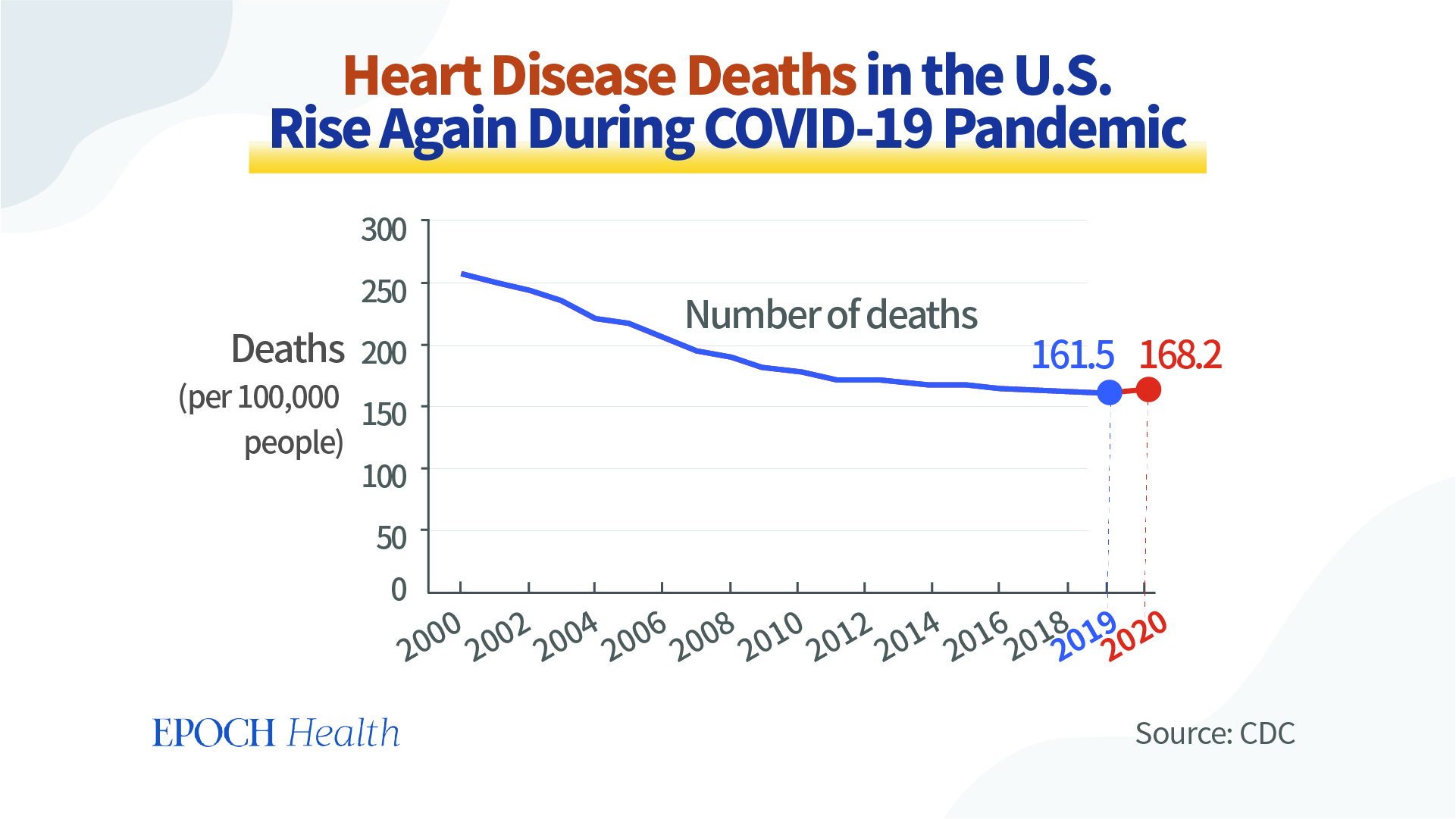
The number of heart disease complications in critically ill COVID-19 patients are much larger than average.
A 2020 article published in the British Medical Journal analyzed 5,019 COVID-19 critically ill patients in the intensive care units of 68 hospitals across the United States, and found that 14 percent of them had cardiac arrest, and only 12 percent of those survived the cardiac arrest after receiving CPR.
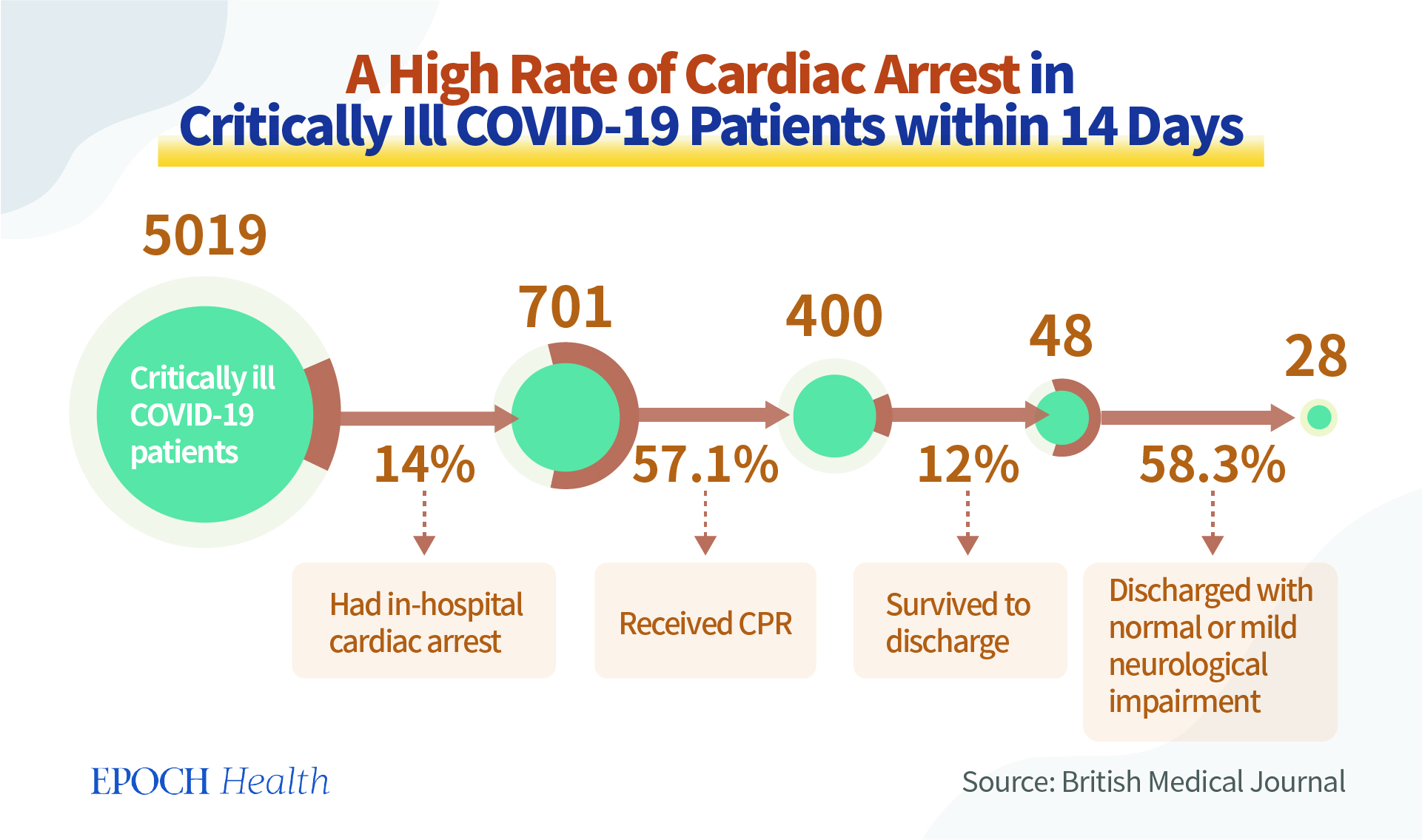
The number of cardiac arrest cases outside of the hospital also saw a significant increase. Many who contracted COVID-19 and experienced cardiac arrest at home passed away before the ambulance arrived. Data provided by the Houston Fire Department, for example, showed just this. Forensic data confirm that the increase in such deaths is directly linked to SARS-CoV-2 infection.
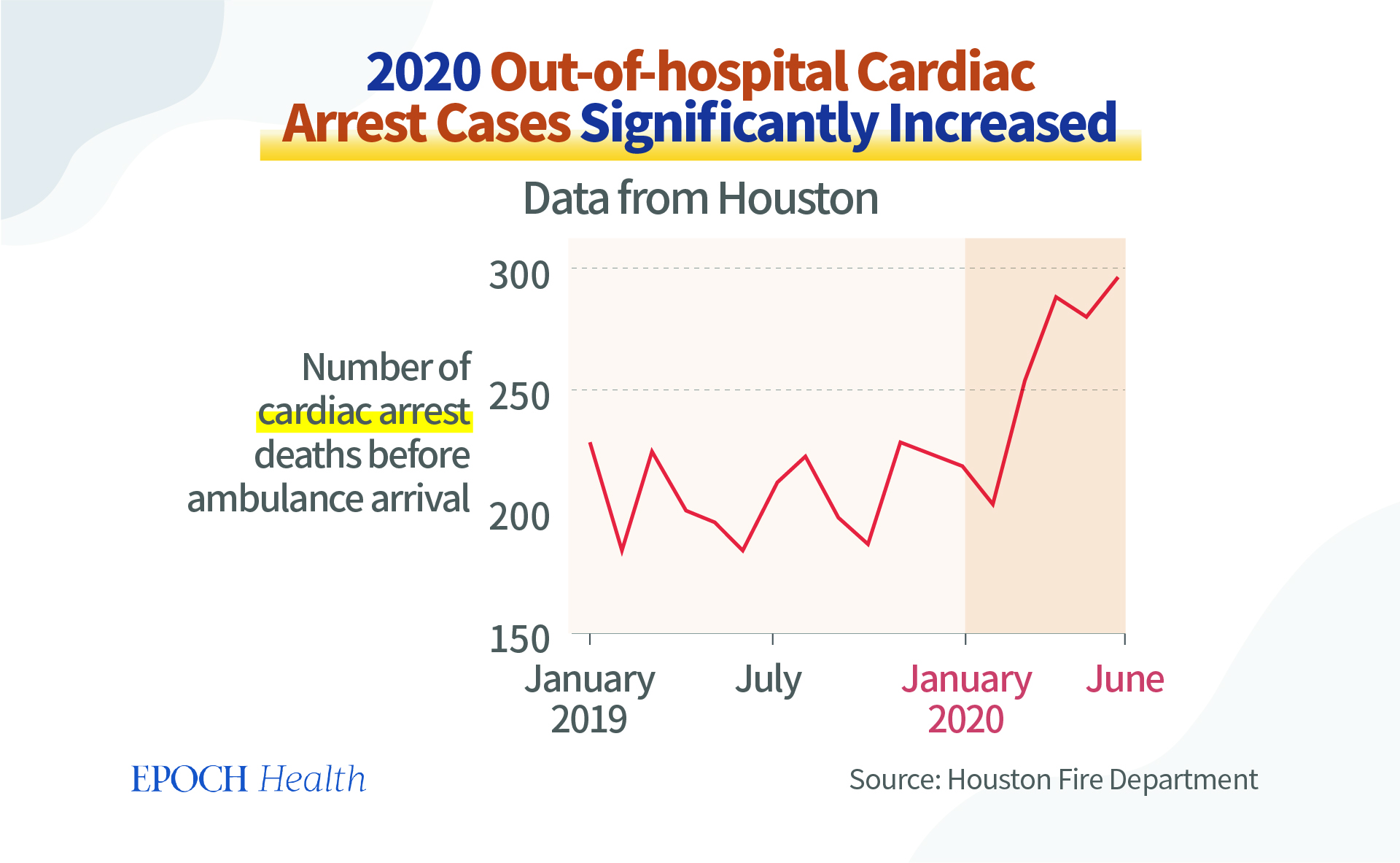
Similar situations have also occurred in other countries and regions.
An Italian study published in The New England Journal of Medicine found that after the COVID-19 pandemic started in Europe in 2020, the number of out-of-hospital cardiac arrest cases increased significantly, by 58 percent compared to 2019. In addition, the number of COVID-19 infections was found to be directly positively correlated to the number of out-of-hospital cardiac arrest cases. Also, 77 percent of all patients who died from out-of-hospital cardiac arrest were suspected of or confirmed having contracted the SARS-CoV-2 virus.
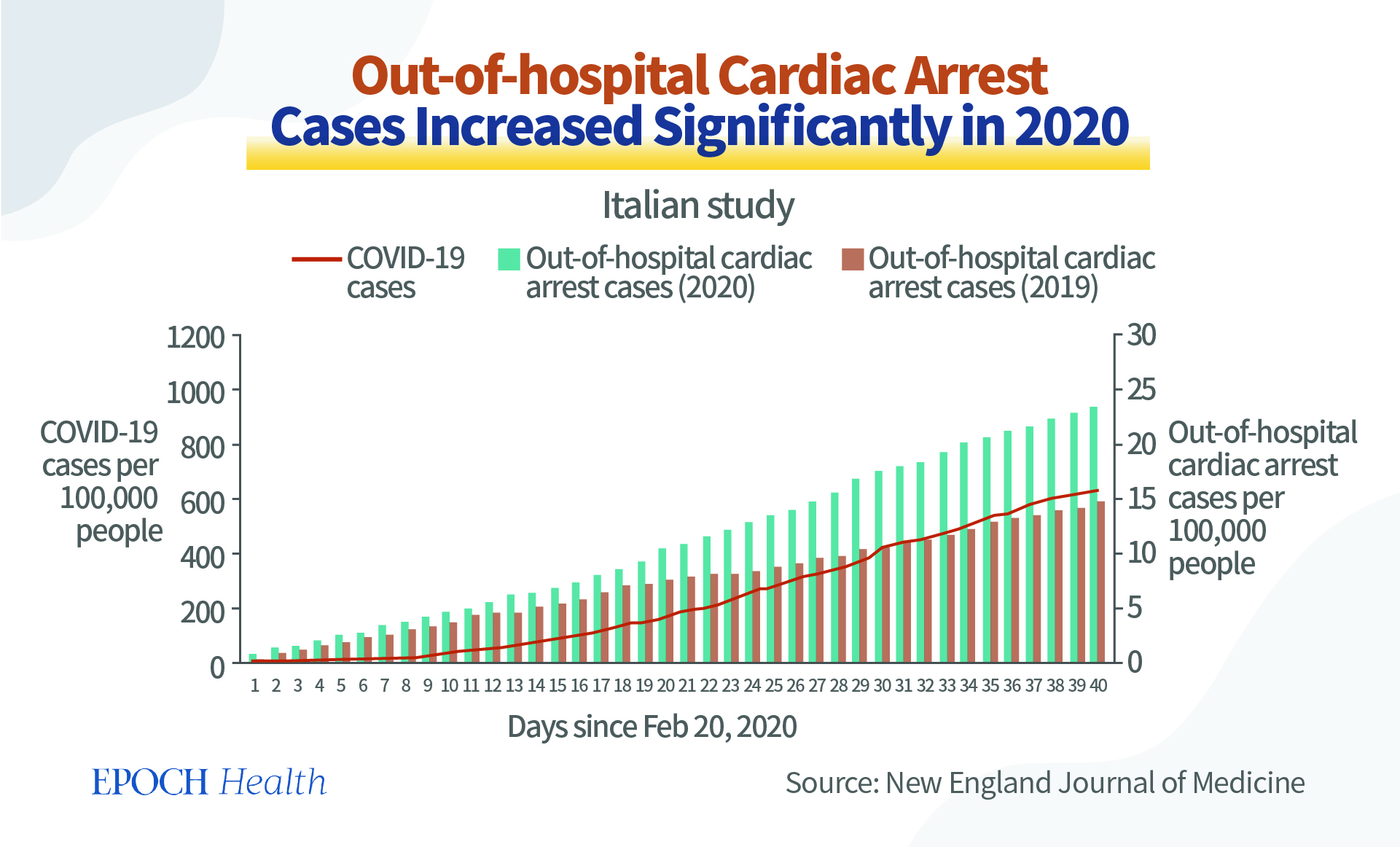
A 2020 large-scale cohort study from Paris published in The Lancet Public Health showed that since March 2020, when the pandemic started spreading rapidly, the number people who died of an out-of-hospital cardiac arrest in Paris had increased dramatically, essentially doubling the number before the pandemic (looking at the same weeks in 2019).
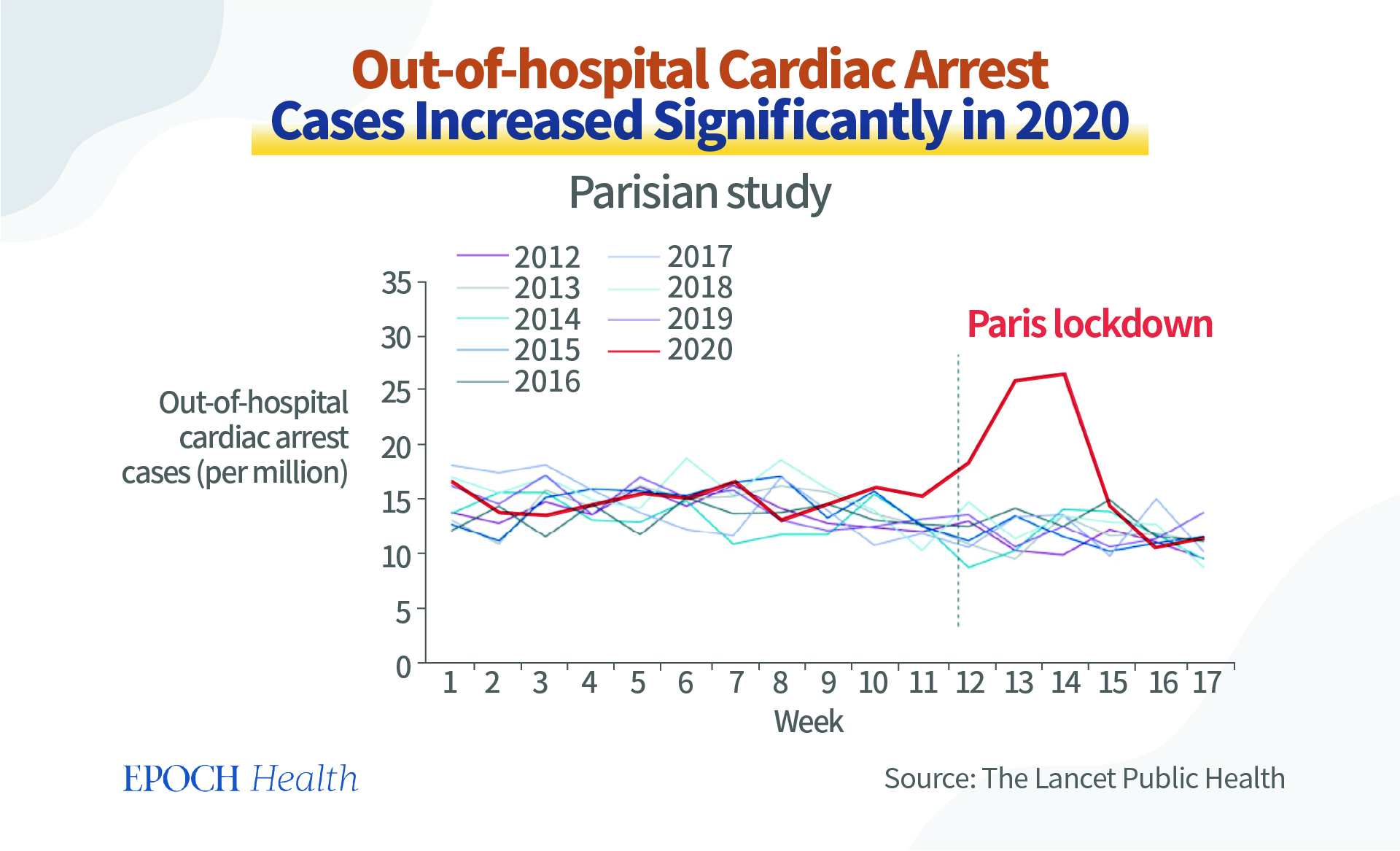
COVID-19 is widely regarded as a virus that affects the respiratory tract, so why have so many patients passed away due to heart disease? The reasons are as follows:
An article published in the Indian Heart Journal listed several leading causes of sudden cardiac death due to COVID-19 infection. The leading causes were acute myocarditis and pericarditis; followed by acute coronary syndrome and hypoxia; there were also coagulopathy, systemic inflammatory responses, and arrhythmia.
In addition to COVID-19 infections, the administration of COVID-19 vaccines has also increased the risk of heart disease. A study published in the Journal of the American Medical Association (JAMA) in August 2021, by using data collected from more than 40 American medical institutions, shows that the number of myocarditis and pericarditis cases increased sharply after around 2 million people received the COVID-19 vaccines in the United States.
The median onset of myocarditis is around 3.5 days after vaccination, and there is a strong correlation between the time of onset and the time of vaccination. Among the myocarditis patients, 80 percent developed the symptoms after the second dose, 75 percent were male, and their median age was 36 years old.
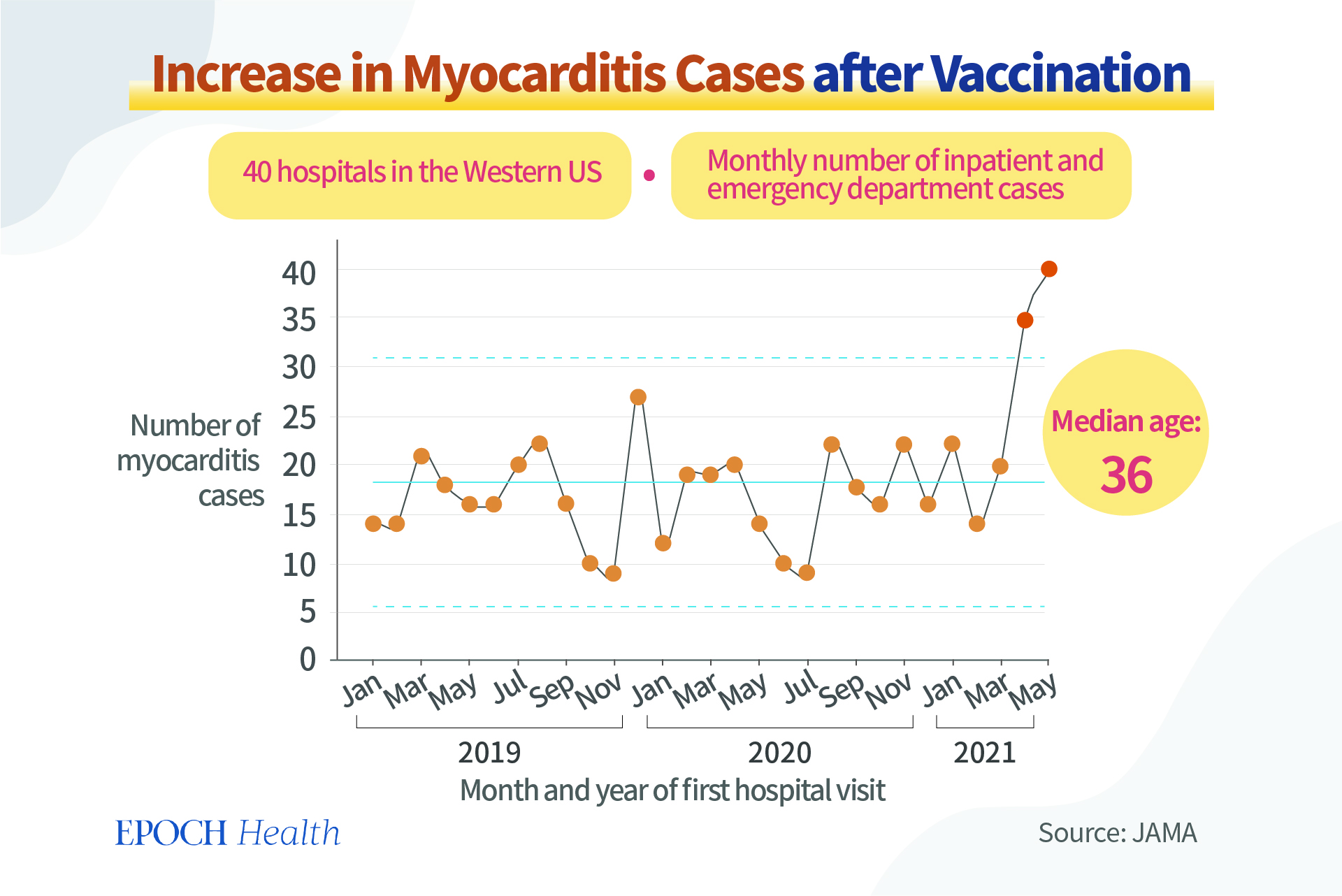
The median onset of pericarditis in patients is 20 days after receiving the COVID-19 vaccines; and in 60 percent of the cases, the onset of symptoms took place after the second dose. Among these patients, 73 percent were male, and their median age was 59 years old.
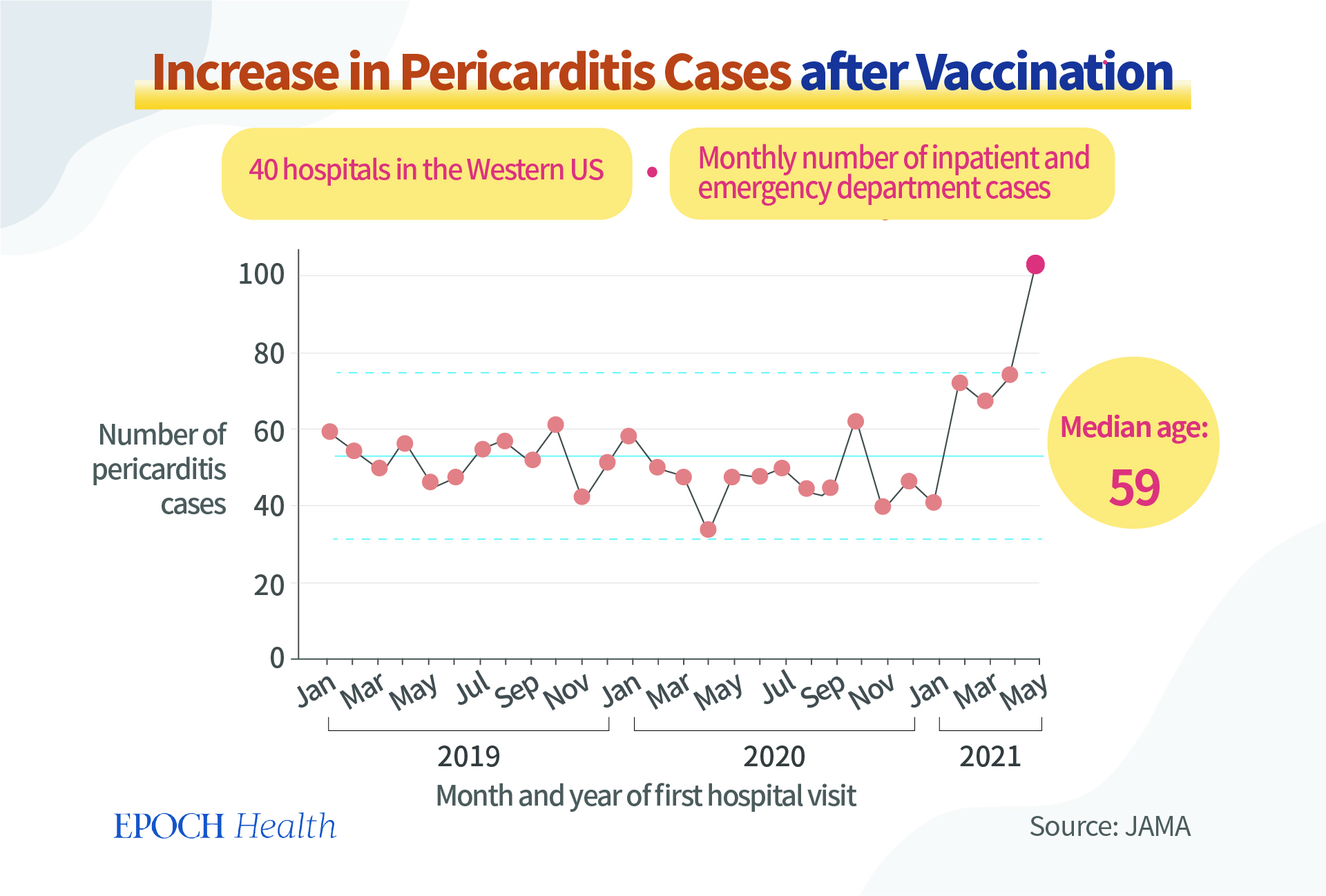
As a result, three countries in Europe suspended the use of the Moderna vaccines for young men at that time.
The second leading cause of death during the first year of the pandemic was cancer. This, however, differs from heart disease, as the number of cancer patients did not have any abnormal fluctuations in terms of data trends during the pandemic.
Nevertheless, COVID-19 infections did have an impact on cancer patients during this time period.
This is because a COVID-19 infection can cause chronic inflammation, and the inflammatory factors can directly or indirectly inhibit the functions of immune cells. The spike proteins of the SARS-CoV-2 virus can also inhibit mitochondrial functions and suppress the cells’ DNA repair mechanisms. The aforementioned effects can all cause the degeneration of the immune cell functions, further aggravating the cancer patients’ conditions and causing their tumors to worsen and spread.
Also, the prolonged lockdowns during the pandemic could lead to or increase the levels of anxiety and depression, which could both inhibit the immune cells’ ability to surveil and suppress tumors.
In addition, since hospitalization rates rose sharply due to the COVID-19 pandemic, many cancer screening, surgery, and chemotherapy appointments have been postponed. A review in The Lancet Public Health comprehensively discussed the consequences of postponing cancer-related appointments. Early screening and diagnosis of cancers (such as colon, breast, prostate, and cervical cancers, as well as melanoma) have a large impact on patient survival. For instance, for each 4-week delay in treatment for colon cancer, the risk of death increases by 6 percent; while a similar delay in adjuvant chemotherapy for colorectal cancer increases the risk of death by 13 percent.
As of May 9, 2021, Australia had attributed the deaths of 7,509 cancer patients to the pandemic.
How can one reduce the risk of heart disease and cancer?
Since the onset of the pandemic, people have been under a lot of pressure, stress, and anxiety, which affects their immunity. Furthermore, being prone to anxiety puts one at further risk for heart disease.
In the movie Kung Fu Panda, the term “inner peace” is repeatedly mentioned. Recently, more and more studies have found that “inner peace” is closely related to one’s health.
In 2016, researchers from the University of Connecticut and University of Oregon jointly published a study in the journal Health Psychology to explore the association between a state of spiritual peace and the survival rate of patients with congestive heart failure (CHF).
Congestive heart failure is a very common chronic disease in the United States, affecting more than 5 million people. Factors such as smoking, poor diets, alcohol consumption, depression, and a lack of social support are all associated with the increased risk of death in patients with congestive heart failure.
The study followed 191 patients with congestive heart failure for five years. One of the items assessed the subjects’ state of spiritual peace and harmony, asking them to rate their own state and frequency of spiritual peace from “never or almost never to some days” to “most days or many times a day.”
The results showed that a state of spiritual peace could be an important predictor of mortality. During the five-year follow up, people who felt peace of mind regularly had a very low or close to zero risk of death, while those who experienced little or no peace of mind had a 25 percent mortality rate.
Even after taking other factors into consideration, spiritual peace still played a role in reducing mortality rate.
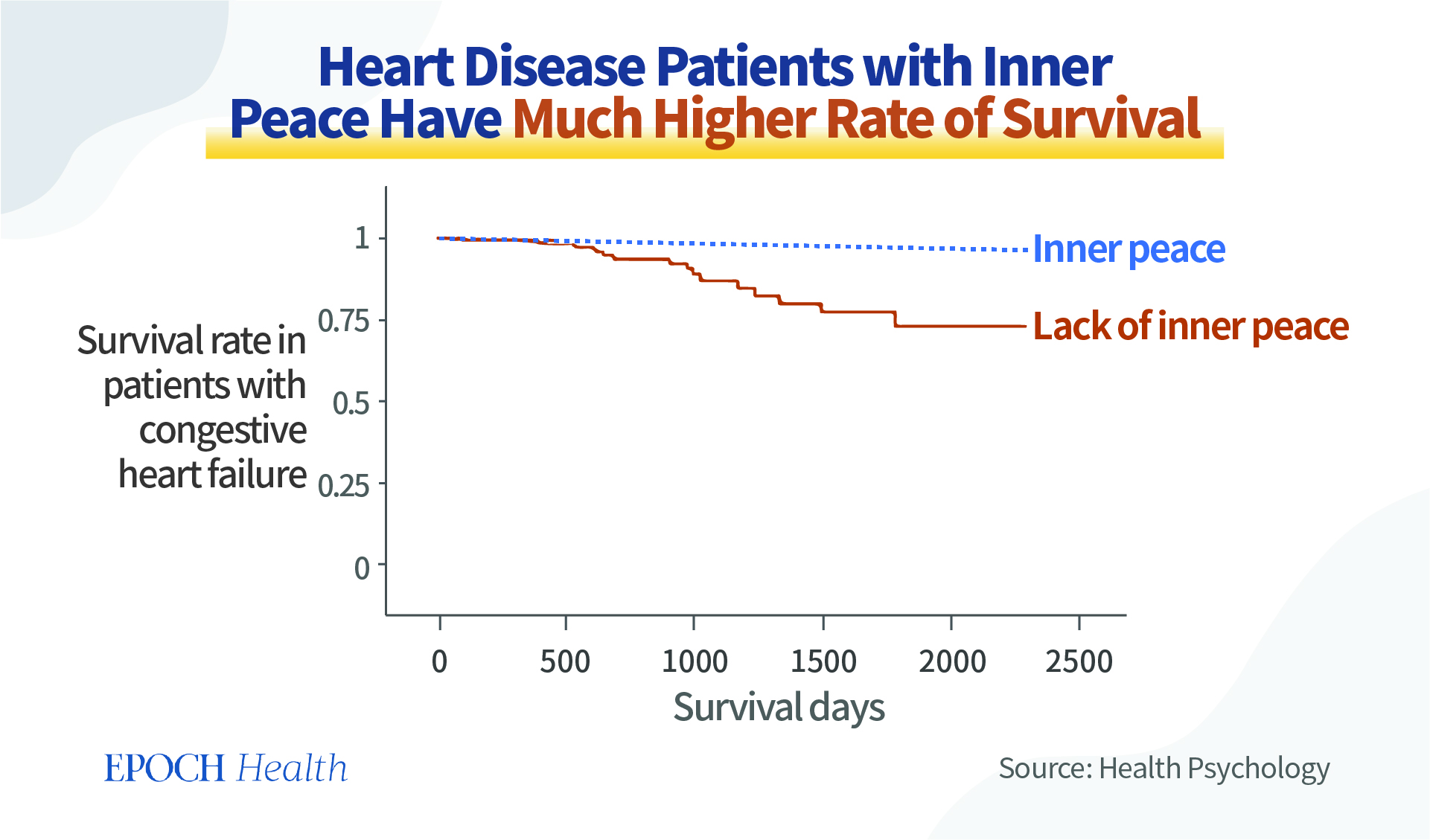
A state of spiritual peace also has a positive effect on cancer patients. Another study has discovered that life meaning and peace was negatively associated with anxiety, and positively associated with physical well-being. For cancer survivors that suffer from a high level of anxiety, their physical health would improve significantly when they had a higher level of inner peace and meaning of life.
However, for people who don’t feel anxious, their health is usually already much better than people who suffer from anxiety. Therefore, after becoming even more calm, their physical condition doesn’t show any obvious changes.
A lot of people might ask, “How can I have spiritual peace?”
If we pay more attention to our spiritual pursuits, and less to our materialistic pursuits, and remind ourselves to remain calm when facing conflicts, then it will be easier for us to obtain inner peace. For materialistic people who can’t let go of their emotions and love to pick a fight in the face of conflicts, it will be quite difficult to reach inner peace.
There is another term to describe a state of spiritual peace, namely spirituality, and this is usually used to represent a divine feeling or a “holy” state of mind. In medical research, spirituality is more commonly used to describe inner peace and a feeling of meaningfulness in life. This is a state of mind that takes spiritual cultivation, and it requires continuous restraint and effort to achieve.
So our attitude decides our fate. Reducing the number of fights with others and achieving more inner peace, our hearts will be thankful to us, and we will be rewarded with a longer, healthier life.
References
State Declines in Heart Disease Mortality in the United States, 2000–2019 | NCHS Data Brief | CDC
Mortality in the United States, 2020
https://www.ncbi.nlm.nih.gov/pmc/articles/PMC7204428/?report=reader#!po=50.0000
COVID-19 and sudden cardiac death: A new potential risk – PMC
Myocarditis and Pericarditis After Vaccination for COVID-19 | Cardiology | JAMA
Impact of the COVID-19 pandemic on cancer incidence and mortality – The Lancet Public Health
Spiritual Peace Predicts 5-Year Mortality in Congestive Heart Failure Patients – PMC

Humans For Food
Australian Researchers Look For Way To Make Edible Insects Marketable
The University of Adelaide is set to undertake a new study to develop accurate and consumer-friendly descriptions for edible insects, one of the most sustainable and protein-rich food sources known.
According to a media release on Tuesday, despite the excellent nutrient profile and known sustainability of edible insects, a lot of work still needs to be done before consumers will consider including bugs like mealworms, crickets, grasshoppers, and native ants in their diets.
Adelaide University PhD researcher Ishka Bless says part of the solution is to better understand the barriers to eating insects, especially in Western countries, and then develop strategies to overcome them.
“One of these barriers is a lack of Western consumer experience with insects as food,” she said.
“We can often feel hesitant about trying new foods because we don’t know what flavours and textures to expect. Having an accurate description of what people can expect when eating insects that have been farmed and prepared for human consumption may help them overcome some of the negative connotations often associated with insects, such as ‘pest’ and ‘creepy crawly’.”
Bless added that this may also give the food industry a better idea of how to incorporate insects into new products and on restaurant menus. Currently, the flavours and textures aren’t well described for industry use.
To develop these new descriptions, as part of her PhD, Bless is recruiting taste testers to taste and describe a range of commercially available farm-raised edible insects such as those mentioned above.
Various cooking techniques will be used, and the tastings will be conducted at the University of Adelaide’s Waite campus in March and April.
Once collected, the descriptions will be used to create a vocabulary and sensory wheel, which represents the sensations produced in experiencing the flavour and texture of each insect dish.
This information will then be socialised further in consumer focus groups and with industry.
Eating insects, also known as entomophagy, is common across Asia, Africa, and Latin America. Outside these regions, the market is growing in European countries such as the Netherlands, France, the UK and Belgium, and emerging in Australia.
Edible insects such as mealworms and crickets are available online, but due to low demand, they are still quite expensive.
Bless said that considering population growth and climate change, transitioning to sustainable and resilient food sources will be critical to food security, and edible insects may have an important role to play in providing an alternative source of protein.
“So if we can help to get people more comfortable with insects as a food and ingredient by breaking down some of the barriers, such as better describing the experience of entomophagy, we may be able to help people incorporate a few bugs into their diets,” she said.
A 2019 report by the CSIRO titled “Edible insects: A roadmap for the strategic growth of an emerging Australian industry” states that Australia is well-positioned to be a player in the global edible insect market due to having a long tradition of agricultural innovation, as well as a diversity of insects.
The report pointed out that among ways to achieve this, Australia must establish new collaborative partnerships among First Nations Peoples, researchers, industry, and government; co-develop First Nations Peoples’ owned and led initiatives; improve Western perceptions of eating insects; identify and incorporate native insect species to promote an ecologically sustainable industry; and produce new edible insect foods that are delicious, nutritious, and accessible to help improve the Australian diet.
“Increasing investment, ongoing collaborations, as well as research and development, are key for Australia to become an international player in producing Australian-branded edible insect products, that are nutritious, delicious, sustainable, and ethically sourced,” the report says.
“This can contribute to meeting the global challenge of achieving food security.”